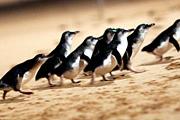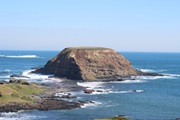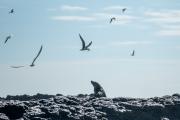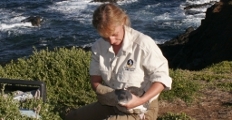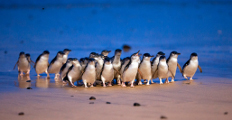Protecting Little penguins from high temperatures
A new research project is heat-mapping the habitat of Phillip Island’s little penguins to help protect them from the fatal effects of hot weather.
Phillip Island Nature Parks and Latrobe University researchers are creating the heat map to determine the coolest areas to place new burrows and to identify warmer areas where more natural shading from vegetation could be introduced.
This involves placing 150 loggers at penguin-height across the Summerland Peninsula to record the temperature and humidity across different habitats every 30 minutes. The recordings are being taken from January to April, with the entire project expected to be complete by the end of this year.
Little penguins are highly susceptible to heat stress during the moulting season from February to April every year. During this time the little penguins fatten up – almost doubling their body weight – before spending around 17 days in their burrows to undergo a “catastrophic moult” where their bodies heat up further because of the energy required and their increased body fat.
During the 2019 moulting season, hundreds of little penguins died after several days above 35 degrees, despite the Nature Parks’ best efforts to save them. It was the greatest heat-related loss on record.
“Little penguins’ bodies can go into meltdown when the temperature in their burrow reaches 35 degrees or higher. Climate change means we are seeing more extreme weather and more frequent heatwaves, and this becomes an issue for penguins on land during moulting season,” Phillip Island Nature Parks research director, Dr Peter Dann, said.
“As you can imagine, it’s incredibly upsetting to see our little penguins go through such an experience. We came up with the idea to map the Summerland Peninsula to find the coolest places to encourage penguins to breed and moult.
“Changing vegetation can impact the ‘micro-climate’ of the penguin breeding area and will provide a refuge for penguins. It’s a slow process, with mostly new birds using the new burrows that will be placed in the cooler areas, but we’re confident it will make a difference.”
The heat mapping is the second stage of work to protect the penguins against rising temperatures. In 2020, as a shorter-term measure, the Nature Parks and Latrobe University installed 50 artificial burrows with different insulation and air flows that were designed to test the micro-climates of the different designs
“During moulting season, little penguins are constrained to land in some of the hottest parts of the year – and just like we can design our own houses and gardens to reduce heat, we can do that for penguins too,” La Trobe University PhD Student, Lauren Tworkowski, said.
“Climate change is one of the biggest potential threats to little penguins. These simple measures can make a huge difference to protect the penguins in the interim while we tackle the broader issues of climate change.”
The projects have been funded by a $25,000 grant to the Penguin Foundation from the QBE Foundation’s Local Grants Program.
“This project not only raises awareness of the impacts of climate change on a beloved animal, but also has the potential to help us better understand how to deal with increased heat stress,” says QBE Foundation Co-Chair, Jon Fox.
“We’re so pleased to be supporting the Penguin Foundation who are working to improve the resilience and preparedness of Australia’s penguin wildlife.”
The results of the study and data modelling, which will produce a heat-map of the entire Summerland Peninsula, will be ready later this year. From the results, a plan to increase shading and remove fire-prone vegetation across the penguin habitat, will be developed.





